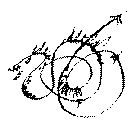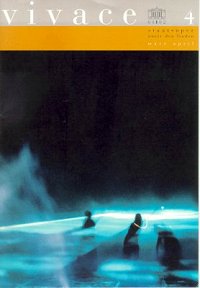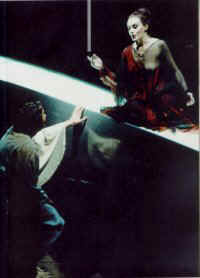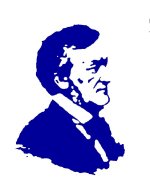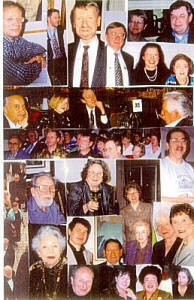|
The
Wagner Society |
|
|
|
FOR IMMEDIATE RELEASE Berlin Wagner Festival 2002: A ReviewStaatsoper unter den Linden,
Berlin, Germany
|
|
Berlin Festival 2002 The Summation of an Epoch: Ten Operas Conductor Director Set Designer Costume Designers Berlin Symphony Orchestra |
The Wagner orgy in Berlin in March and April lured Wagner fans from all over the US to this exciting and lovely city. "The Ten" Wagner operas were performed in two cycles at the Staatsoper unter den Linden. Daniel Barenboim conducted all and Harry Kupfer directed. Hans Schavernoch created the sets, and costumes were by Christine Stromberg and Buki Shiff. Having split a ticket with a Dallas friend, I was there for the last five performances only, beginning with Siegfried. This event happened once before, in 1933, and it made us feel blessed to have it happen again in our lifetime. I loved all the performances -- because I am a Kupfer fan -- but there were some odd sets.
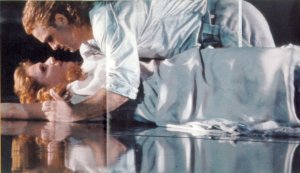
Debra Polaski and Christian Franz
I am also a Debra Polaski fan and was pleased with her Brunnhilde and Isolde. She may never rank with the greatest in these roles, but she has grown tremendously from the first time I heard her in Bayreuth and people said that she would never sing the role. Christian Franz sang a satisfactory Siegfried.
Graham Clark is my favorite Mime, and Falk Struckmann performed an effective Wanderer. Huge standouts were John Tomlinson as Hagen and later as Gurnemanz. And, of course, people went wild when Rene' Pape sang Konig Marke and Pogner in Meistersinger.
A young singer to watch was Stephan Rugamer as David in this opera and as the shepherd in Tristan. An ageing Reiner Goldberg stepped in to save the day as Walter von Stolzing when Francisco Araiza could not perform in that role. One soon could forget his age as he took over this role with his voice and his acting.
|
|
Probably the most spectacular of all was Waltraud Meier as Kundry. It would be difficult to imagine a better singer in this part. A better collection of voices could not have been assembled.
One reason that I like Harry Kupfer is that he has everyone acting the part, and he knows how to intensify relationships. The orchestra and chorus were excellent--although not as wonderful as in Bayreuth--and Barenboim usually does the correct interpretation, although he did let the orchestra sound too loud in places.
A few of the sets and staging were strange: Tristan took place on the backside of a huge winged angel, and the singers had to scramble over this rotating figure precariously. During intermission, someone in the audience said that she was tired of looking at the angel's "buns." Another oddity was that we viewed the Blumenmadchen as body parts on television screens: a tit here, an eye there, and a leg somewhere else. Viewed in whole at the end, when they came out for a bow, they were all very attractive women.
A Cycle of Brahms Symphonies
Sandwiched in between the operas, Barenboim managed to conduct all of the Brahms symphonies on two nights in the beautiful Wiener Musik Verein style Konzerthaus on the Gendarmenplatz. As with the opera performances, the audience applauds on and on and doesn't want to leave. When these people stood up, it was not for a hiccup on stage or for a quick getaway, but for real appreciation of the performance.
Schubert's Die Winterreise
The high point of these wonderfully special events was, however, for me, not Wagner at all, but a Liederabend recital: Roman Trekel sang Schubert's Winterreise with Irwin Gage at the piano. I had missed this young baritone as the king's herald in Lohengrin, but was absolutely mesmerized by his performance here. His body scarcely moved at all for the entire cycle, but the expression on his face and in his eyes and in his voice was thrilling. This was the ultimate Winterreise for me; I could not ever hear a more perfect performance of this great Romantic work.
Parties, Receptions, and Other Events
Other pleasant events included an interview with Deborah Polaski and reception. She looked lovely and was charming as she talked about how she always felt sad -- as I do -- at the end of a Ring Cycle and thought about what the next one would be.
Another event was a birthday party for Falk Struckmann given by Dr. Sherwin Sloan of LA. (He is the best Wagner party giver in the world!)
Altogether, I knew at least twenty people from the US and a few from Europe, and most of us dined and partied together after the performances. Sherwin Sloan brought an LA group, and Aurelius Fernandez, the President of the Wagner Society of Washington, D.C., came with several of his members. I rented an absolutely brand new apartment with one of them, Betty Byrne, and, of course, we gave a party. Dallas members were Alain-Pierre Vuilleret, Jerry Housden, whose tickets I shared, Roger Carroll, Josef Suter from New Orleans, Chris Farmer from LA, and Bruce Bisenz and Lettie Sandoval, also from LA.
This was such an outstanding event for me that I was moved to join the Freunde und Furderer der Deutschen Staatsoper. I hope to go again to Berlin, but such an event will not likely be repeated in my lifetime anyway.
Founded in 1992 by Virginia Richey Abdo and Dr. James T. Wheeler, the Wagner Society of Dallas has had an active presence in the musical life of Dallas since that time. As the WSD continues to grow and expand, it is having a wider and wider influence among musicians and performing arts institutions in North Texas, as well as with music lovers throughout the Metroplex area. The Wagner Society of Dallas is now creating a presence on the internet as a tool to promote the music of Richard Wagner, and classical music in general, to the widest possible audience. Through the medium of its own web page, regular meetings, participation in musical events in the Dallas area, and attendance at opera performances across the country and around the world, the Wagner Society of Dallas is becoming an important source of Wagner information on the World Wide Web.
For More Information Contact:
Wagner Society of Dallas
P.O. Box 25201
Dallas, TX 75225-0201
Web Address: www.WagnerDallas.com
E-Mail: WSD@WagnerDallas.com
WebMaster: eflaspo@aol.com

Welcome to The Wagner Society of Dallas. You know, as Texans, we're bound to strive for being the biggest and best of all the Wagner groups in the world over. My hope, in addition, is that we ensure your attendance and participation by offering an interesting, stimulating, and enjoyable array of meetings, recitals, and travel. Let us know if you have suggestions for future activities, and do make an effort to join in during the coming months with your membership, attendance, and above all joy of being with fellow Wagner aficionados. Roger Carroll The Wagner Society of Dallas - Virginia R.
Abdo and Dr. James T. Wheeler, The Wagner Society of Dallas is devoted to furthering the enjoyment and appreciation of the music of Richard Wagner. The Dallas group is one of many Wagner Societies all over the world. It is a non-profit organization open to anyone who enjoys the works of Richard Wagner and who would like to participate in the Society’s activities. The Wagner Society of Dallas has monthly meetings and programs which feature recitals, lectures, video screenings, receptions for opera singers and personalities, and trips to Wagner performances in other cities. We welcome music lovers who are already familiar with Wagner’s works as well as those who may want to become more knowledgeable about Wagner’s music. Member Benefits include attendance at programs, our newsletter, discount on books and CD’s, advance notice of events and selected ticket services, receipt of the Membership Directory, ticket allotments to Bayreuth, and an active link with fellow Wagnerians throughout the world. |
